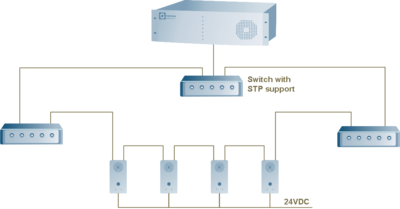Difference between revisions of "Daisy chaining of IP Stations"
From Zenitel Wiki
| Line 1: | Line 1: | ||
[[Image:DaisyChainingOFIPstations.png|thumb|400px]] | [[Image:DaisyChainingOFIPstations.png|thumb|400px]] | ||
| − | + | ==Daisy chain== | |
The IP stations have a built-in two port switch. The ’AUX’ port can be used to connect a second IP station, and to the ’AUX’port of the second station can be connected to a third station. Up to 10 IP stations can be daisy chained in this way. | The IP stations have a built-in two port switch. The ’AUX’ port can be used to connect a second IP station, and to the ’AUX’port of the second station can be connected to a third station. Up to 10 IP stations can be daisy chained in this way. | ||
<br> | <br> | ||
Revision as of 15:45, 5 August 2009
Daisy chain
The IP stations have a built-in two port switch. The ’AUX’ port can be used to connect a second IP station, and to the ’AUX’port of the second station can be connected to a third station. Up to 10 IP stations can be daisy chained in this way.
Daisy changing IP Stations reduces cable length
Loop configuration, using the spanning tree protocol
- Spanning-Tree Protocol (STP) is a link management protocol that provides path redundancy while preventing undesirable loops in the network. For an Ethernet network to function properly, only one active path can exist between two stations.
- To provide path redundancy, STP defines a tree that spans all switches in an extended network. STP forces certain redundant data paths into a standby (blocked) state. If one network segment in the Spanning-Tree Protocol becomes unreachable, or if STP costs change, the spanning-tree algorithm reconfigures the spanning-tree topology and reestablishes the link by activating the standby path


